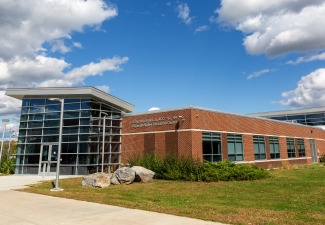SUNY Plattsburgh Assistant Physics Professor Ken Podolak and Students Make Instant Slushies
For SUNY Plattsburgh Assistant Physics Professor Ken Podolak, frigid temperatures are but an opportunity to create tasty treats.
After all, why venture out to a gas station to get a slushy from a machine when the frozen novelty can easily be conjured up in a soda bottle?
Inspired by a story on National Public Radio about fun things to do in the cold, Podolak recently invited two of his students, sophomores Ashley LeVasseur and Justin Collins, back to campus during winter break to give slushy making a whirl.
“We just thought it’d be fun,” LeVasseur said.
Shake Vigorously
With the temperature near single digits and considerably colder wind chill on Tuesday (Jan 7), the three science enthusiasts bundled up and headed to the slippery sidewalk near the bank of ice-covered Hawkins Pond.
They began by positioning several plastic bottles of various flavors of soda in a snowbank to chill.
“You’ve just got to watch it carefully,” Podolak said. “You’ll actually see, if you leave it out there long enough, little ice crystals forming on the top.”
But one need not wait for the entire contents of the bottle to crystallize on its own, he noted.
Once the first flakes of ice appeared, Podolak and his students expedited the slushy-making process by vigorously shaking the bottles, causing more of the liquid to freeze instantaneously.
“It will actually form ice really quickly, and you get a lot of slush really fast,” the assistant professor explained.
It’s important, however, he noted, to depressurize the bottle before shaking it.
“You crack it (the cap) just so that the bottle doesn’t expand too much, and then you can close it and then shake it (the bottle) or tap it,” Podolak said.
Stays Carbonated
LeVasseur and Collins advised against attempting the project with soda in cans or glass bottles.
They also found that regular colas, like Pepsi and Coke, and non-colas, like Sprite and 7-UP, worked well; though, diet sodas were not as cooperative.
“The diets really formed a big chunk of ice and didn’t really come to slushy-like mixtures,” Podolak said.
When outside in a temperature of about 10 degrees, he noted, 2-liter bottles should be ready to shake in about three to four hours, while 16-ounce bottles should start forming crystals in an hour or less.
The homemade slushies also retain their carbonation, LeVasseur noted, unlike those made in a machine, which is constantly turning, thereby eliminating the bubbles.
“If you have a frozen Coke or something from a store, it doesn’t retain the carbonation, where, in this case, you still have the bubbles,” Collins added.
“In this process, instead of freezing the whole thing, it’s freezing just the water, or the liquid inside, leaving the syrup and the carbonation.
This article originally ran as “Frigid Temps Inspire Instant Slushies” in the Jan. 10 issue of the Press-Republican. It was reprinted with permission.
News

SUNY Adirondack Students Benefit from New Dual Agreement with SUNY Plattsburgh Queensbury
